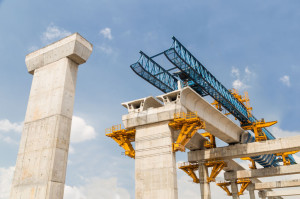How infrastructure jobs and the construction sector come together
 Infrastructure is a hot topic today thanks to the Biden administration’s infrastructure bill. This comes during a time when municipalities all over the country are struggling with crumbling roads and bridges. Here in Utah, the bill is already bearing fruit with $25.4 million awarded to two projects designed to modernize Utah’s infrastructure. Many within the contracting and construction sectors rejoiced at the passage of this bill as it would mark a huge windfall for construction companies contracted to handle infrastructure projects. So, how will the infrastructure bill impact the construction industry? We take a closer look at this very question in our today’s blog post.
Infrastructure is a hot topic today thanks to the Biden administration’s infrastructure bill. This comes during a time when municipalities all over the country are struggling with crumbling roads and bridges. Here in Utah, the bill is already bearing fruit with $25.4 million awarded to two projects designed to modernize Utah’s infrastructure. Many within the contracting and construction sectors rejoiced at the passage of this bill as it would mark a huge windfall for construction companies contracted to handle infrastructure projects. So, how will the infrastructure bill impact the construction industry? We take a closer look at this very question in our today’s blog post.
When Infrastructure, Engineering, and Construction Come Together
Infrastructure construction and civil engineering companies come together to complete big projects. And some big projects are coming to fruition thanks to the infrastructure bill. They include everything from roadways to bridges, highways, dams, pipelines, rail systems, ports, public transportation, wastewater treatment and more.
There are many segments and business types within the infrastructure and construction industry. They range from homebuilders to companies that support massive government-funded projects. It will be those working in public/private partnerships that stand to benefit from the huge financial windfall contained within the infrastructure bill. Some of the biggest infrastructure projects can take many years to complete but have a lifecycle that lasts for many decades, or even a lifetime.
Large infrastructure construction programs often feature a central company that manages the overall project. This is a common procedure to ensure all aspects of the project are properly aligned. Depending on the infrastructure project, this could include hundreds or thousands of subcontractors providing different subcomponents and services. That’s why you need a central company managing every part of the job. In the infrastructure and construction industry, this role is sometimes called the engineering, procurement, and construction (EPC) contractor. Big companies such as Bechtel and Jacobs usually occupy this spot. These companies fill the role of prime contractors in government contracts.
Infrastructure jobs take a lot of money and resources to complete. Projects are generally built to support a fixed maximum use or population and have a specified lifespan. Of course, this can be challenging. After all, how do public and private sector planners accurately predict population density and infrastructure use years into the future? They need to ensure they build systems to support populations many decades out. It isn’t easy, but it can be done and is done every day on infrastructure projects across the country.
Public/Private Partnerships Drive Infrastructure Projects
Large infrastructure projects are generally public-private partnerships to some extent, simply because of the size and scope of the job. Municipalities and state agencies require help from the private sector to ensure these projects are finished. You must also consider money and time spent, as each project’s duration and capital requirements often require government funding. These types of infrastructure projects usually pertain to public property or public goods such as water, power, and transportation networks. There are also toll roads and power plants to consider. In those cases, you see more private spending, but the majority of big infrastructure jobs are still primarily government-sponsored.
Infrastructure projects are managed this way because it would be extremely difficult for companies to build large infrastructure without government help. Why? Because the risk profile and capital requirements for these projects can be astronomical depending on the project. And for companies that are evaluated based on short-term financial results, government help is even more crucial. Many large projects simply would not be built without the involvement of the federal government.
Still, public/private construction projects are not without downsides. While they are necessary for many of these large projects, they’re structurally flawed because they separate the buyer — which is the government in this case — from the citizen user. As a result, this can distort pricing guidelines and cause too much or too little capacity on the project. Of course, this problem is not relegated to the construction sector only. It is a problem that lots of industry verticals deal with, from education to healthcare. That’s why it is so important to put proper controls in place when managing public-private partnership programs. This will ensure there are no financial or job site distortions. It also ensures training and skill on both sides of the partnership.
No two companies are the same. Still, there are common requirements that compel companies who work in the infrastructure and construction industry. These pressures can result in wildly different strategies and tactics, but understanding constraints and compulsions helps frame how the industry operates. And that’s why it is so important to partner with companies and vendors who understand these pressures and have experience working on infrastructure jobs. Here at McNeil Engineering, we fit that bill. Head over to the projects section of our website to see some of the work we have done over the years!
